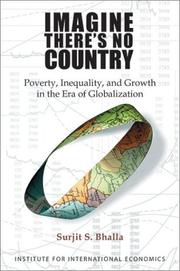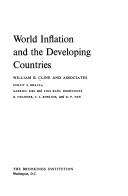| Listing 1 - 9 of 9 |
Sort by
|

ISBN: 0881323489 9786611181710 0881324523 1281181714 9780881323481 Year: 2002 Publisher: Washington, DC : Institute for International Economics,
Abstract | Keywords | Export | Availability | Bookmark
 Loading...
Loading...Choose an application
- Reference Manager
- EndNote
- RefWorks (Direct export to RefWorks)
National wealth --- Economic growth --- Social stratification --- International economic relations --- Income --- Poverty --- Income distribution --- Globalization --- Poverty. --- Income distribution. --- Globalization.
Book
ISBN: 0881326232 0881326518 9780881326512 9780881326239 Year: 2012 Publisher: Washington, DC : Peterson Institute for International Economics,
Abstract | Keywords | Export | Availability | Bookmark
 Loading...
Loading...Choose an application
- Reference Manager
- EndNote
- RefWorks (Direct export to RefWorks)
Devaluation of currency. --- Economic development --- International trade. --- Foreign exchange rates. --- Monetary policy. --- Developing countries --- Commerce. --- Monetary management --- Exchange rates --- Fixed exchange rates --- Flexible exchange rates --- Floating exchange rates --- Fluctuating exchange rates --- Foreign exchange --- Rates of exchange --- External trade --- Foreign commerce --- Foreign trade --- Global commerce --- Global trade --- Trade, International --- World trade --- Currency devaluation --- Money --- Rates --- Devaluation --- Economic policy --- Currency boards --- Money supply --- Commerce --- International economic relations --- Non-traded goods --- Currency question --- Monetary policy --- Devaluation of currency --- International trade --- Foreign exchange rates --- E-books --- 332.414 --- 333.420.1 --- 333.450 --- 333.451.1 --- 333.825 --- AA / International- internationaal --- Koopkracht van geld. Monetaire (on)stabiliteit --- Theorie van het deviezenverkeer. Theorie van de koopkrachtpariteit --- Wisselkoersen --- Deviezenpolitiek. Interventies
Book
Year: 1978 Publisher: Washington (D.C.): World Bank
Abstract | Keywords | Export | Availability | Bookmark
 Loading...
Loading...Choose an application
- Reference Manager
- EndNote
- RefWorks (Direct export to RefWorks)
Book
Year: 1970 Publisher: Washington (D.C.) World Bank
Abstract | Keywords | Export | Availability | Bookmark
 Loading...
Loading...Choose an application
- Reference Manager
- EndNote
- RefWorks (Direct export to RefWorks)

ISBN: 0815714688 9780815714682 Year: 1981 Publisher: Washington (D.C.): Brookings institution
Abstract | Keywords | Export | Availability | Bookmark
 Loading...
Loading...Choose an application
- Reference Manager
- EndNote
- RefWorks (Direct export to RefWorks)
Money. Monetary policy --- Third World: economic development problems --- Developing countries --- Inflation (Finance) --- LDC / Developping Countries - Pays En Développement --- 333.841 --- 336.748.12 --- 339.96 --- -Inflatie. --- Algemeen prijsniveau. Prijsindex. Prijsstijging --- Ontwikkelingshulp. Ontwikkelingssamenwerking. Ontwikkelingsproblematiek --- -339.96 Ontwikkelingshulp. Ontwikkelingssamenwerking. Ontwikkelingsproblematiek --- 336.748.12 Algemeen prijsniveau. Prijsindex. Prijsstijging --- Inflatie. --- 339.96 Ontwikkelingshulp. Ontwikkelingssamenwerking. Ontwikkelingsproblematiek --- Inflatie --- Developing countries: economic development problems --- Inflation (Finance) - Developing countries
Book
Year: 2023 Publisher: Washington, D.C. : International Monetary Fund,
Abstract | Keywords | Export | Availability | Bookmark
 Loading...
Loading...Choose an application
- Reference Manager
- EndNote
- RefWorks (Direct export to RefWorks)
We examine the impact of formal adoption of inflation targeting (IT) on inflation, growth and anchoring of inflation expectations in advanced economies and emerging markets and developing economies (EMDEs). Our paper reports several findings relevant to assessing the success of IT regimes. We find that while the early adopters of IT (pre-2000) all saw declines in inflation rates following adoption, IT adopters since then have enjoyed such success in only about half the cases. Since there is not much difference, on average, between IT and non-IT countries in mean inflation, inflation volatility and the extent of inflation anchoring, it is not easy to sort out what role IT has played in ensuring good outcomes; in particular, we cannot rule out the possibility that the success of IT may be due to ‘regression to the mean’. Our country-level analysis—using the Synthetic Control Method (SCM) to compare outcomes in IT countries to a synthetic cohort—shows that IT adoption delivers significant inflation gains in about a third of the cases. At the same time, we also find limited support for the concern that adoption of IT systematically leads to poorer growth outcomes. At a time when central banks are struggling to keep inflation in check, our results suggest that the belief that IT adoption will be sufficient to achieve this goal cannot be taken for granted.
Macroeconomics --- Economics: General --- Inflation --- Money and Monetary Policy --- Finance: General --- Business Fluctuations --- Cycles --- Expectations --- Speculations --- Price Level --- Deflation --- Monetary Policy --- General Financial Markets: General (includes Measurement and Data) --- Economic & financial crises & disasters --- Economics of specific sectors --- Monetary economics --- Finance --- Prices --- Inflation targeting --- Monetary policy --- Emerging and frontier financial markets --- Financial markets --- Currency crises --- Informal sector --- Economics --- Financial services industry --- Mexico
Book
Year: 2022 Publisher: Washington, D.C. : International Monetary Fund,
Abstract | Keywords | Export | Availability | Bookmark
 Loading...
Loading...Choose an application
- Reference Manager
- EndNote
- RefWorks (Direct export to RefWorks)
The paper presents estimates of poverty [extreme poverty PPP$1.9 and PPP$3.2] and consumption inequality in India for each of the years 2004-5 through the pandemic year 2020-21. These estimates include, for the first time, the effect of in-kind food subsides on poverty and inequality. Extreme poverty was as low as 0.8 percent in the pre-pandemic year 2019, and food transfers were instrumental in ensuring that it remained at that low level in pandemic year 2020. Post-food subsidy inequality at .294 is now very close to its lowest level 0.284 observed in 1993/94.
Macroeconomics --- Economics: General --- Poverty and Homelessness --- Investments: Commodities --- Diseases: Contagious --- Taxation and Subsidies: Externalities --- Redistributive Effects --- Environmental Taxes and Subsidies --- Measurement and Analysis of Poverty --- Government Policy --- Provision and Effects of Welfare Program --- Economic Development: Human Resources --- Human Development --- Income Distribution --- Migration --- Welfare, Well-Being, and Poverty: General --- Macroeconomics: Consumption --- Saving --- Wealth --- Aggregate Factor Income Distribution --- Agriculture: General --- Urban, Rural, and Regional Economics: Household Analysis: General --- Economic & financial crises & disasters --- Economics of specific sectors --- Poverty & precarity --- Investment & securities --- Infectious & contagious diseases --- Poverty --- Consumption --- National accounts --- Income inequality --- Agricultural commodities --- Commodities --- Household consumption --- Currency crises --- Informal sector --- Economics --- Income distribution --- Farm produce --- Communicable diseases
Book
ISBN: 9798400208119 Year: 2022 Publisher: Washington, D.C. : International Monetary Fund,
Abstract | Keywords | Export | Availability | Bookmark
 Loading...
Loading...Choose an application
- Reference Manager
- EndNote
- RefWorks (Direct export to RefWorks)
The paper presents estimates of poverty [extreme poverty PPP$1.9 and PPP$3.2] and consumption inequality in India for each of the years 2004-5 through the pandemic year 2020-21. These estimates include, for the first time, the effect of in-kind food subsides on poverty and inequality. Extreme poverty was as low as 0.8 percent in the pre-pandemic year 2019, and food transfers were instrumental in ensuring that it remained at that low level in pandemic year 2020. Post-food subsidy inequality at .294 is now very close to its lowest level 0.284 observed in 1993/94.
Macroeconomics --- Economics: General --- Poverty and Homelessness --- Investments: Commodities --- Diseases: Contagious --- Taxation and Subsidies: Externalities --- Redistributive Effects --- Environmental Taxes and Subsidies --- Measurement and Analysis of Poverty --- Government Policy --- Provision and Effects of Welfare Program --- Economic Development: Human Resources --- Human Development --- Income Distribution --- Migration --- Welfare, Well-Being, and Poverty: General --- Macroeconomics: Consumption --- Saving --- Wealth --- Aggregate Factor Income Distribution --- Agriculture: General --- Urban, Rural, and Regional Economics: Household Analysis: General --- Economic & financial crises & disasters --- Economics of specific sectors --- Poverty & precarity --- Investment & securities --- Infectious & contagious diseases --- Poverty --- Consumption --- National accounts --- Income inequality --- Agricultural commodities --- Commodities --- Household consumption --- Currency crises --- Informal sector --- Economics --- Income distribution --- Farm produce --- Communicable diseases
Book
ISBN: 9798400229244 Year: 2023 Publisher: Washington, D.C. : International Monetary Fund,
Abstract | Keywords | Export | Availability | Bookmark
 Loading...
Loading...Choose an application
- Reference Manager
- EndNote
- RefWorks (Direct export to RefWorks)
We examine the impact of formal adoption of inflation targeting (IT) on inflation, growth and anchoring of inflation expectations in advanced economies and emerging markets and developing economies (EMDEs). Our paper reports several findings relevant to assessing the success of IT regimes. We find that while the early adopters of IT (pre-2000) all saw declines in inflation rates following adoption, IT adopters since then have enjoyed such success in only about half the cases. Since there is not much difference, on average, between IT and non-IT countries in mean inflation, inflation volatility and the extent of inflation anchoring, it is not easy to sort out what role IT has played in ensuring good outcomes; in particular, we cannot rule out the possibility that the success of IT may be due to ‘regression to the mean’. Our country-level analysis—using the Synthetic Control Method (SCM) to compare outcomes in IT countries to a synthetic cohort—shows that IT adoption delivers significant inflation gains in about a third of the cases. At the same time, we also find limited support for the concern that adoption of IT systematically leads to poorer growth outcomes. At a time when central banks are struggling to keep inflation in check, our results suggest that the belief that IT adoption will be sufficient to achieve this goal cannot be taken for granted.
Mexico --- Macroeconomics --- Economics: General --- Inflation --- Money and Monetary Policy --- Finance: General --- Business Fluctuations --- Cycles --- Expectations --- Speculations --- Price Level --- Deflation --- Monetary Policy --- General Financial Markets: General (includes Measurement and Data) --- Economic & financial crises & disasters --- Economics of specific sectors --- Monetary economics --- Finance --- Prices --- Inflation targeting --- Monetary policy --- Emerging and frontier financial markets --- Financial markets --- Currency crises --- Informal sector --- Economics --- Financial services industry
| Listing 1 - 9 of 9 |
Sort by
|

 Search
Search Feedback
Feedback About
About Help
Help News
News